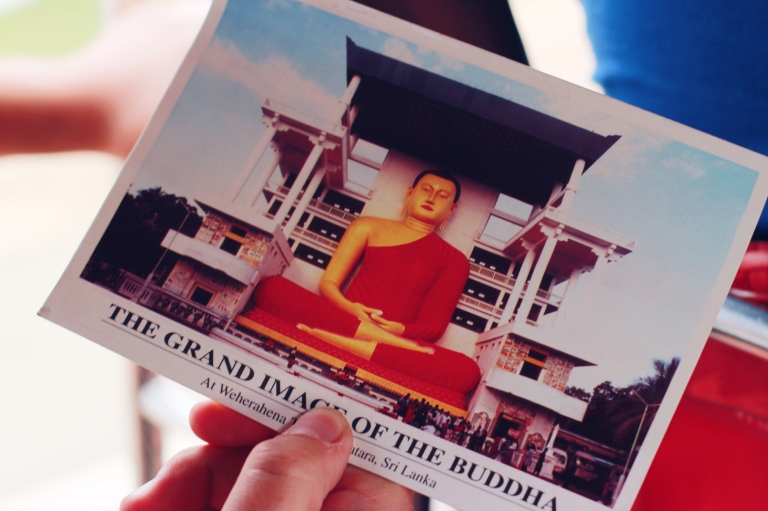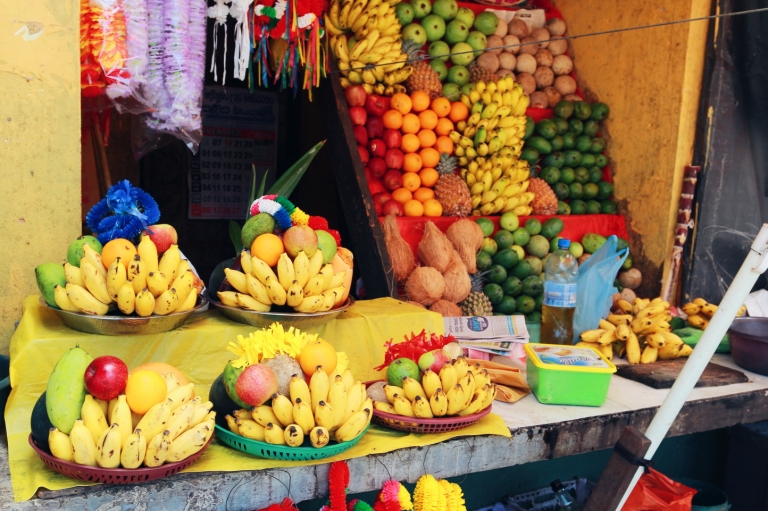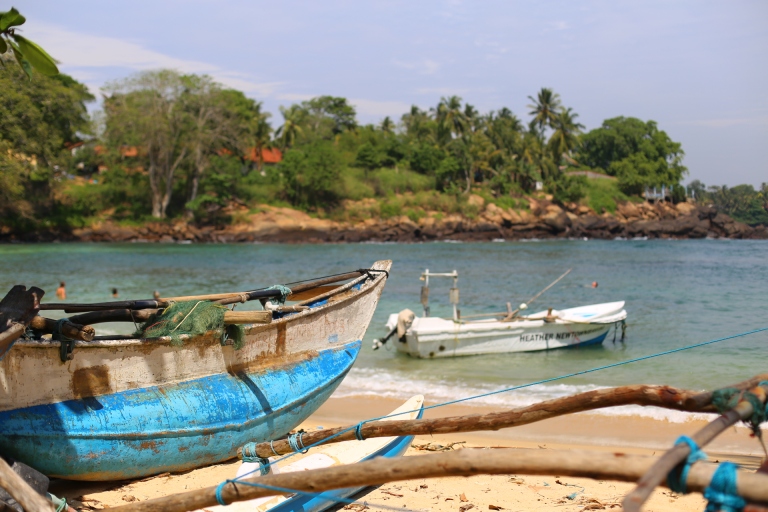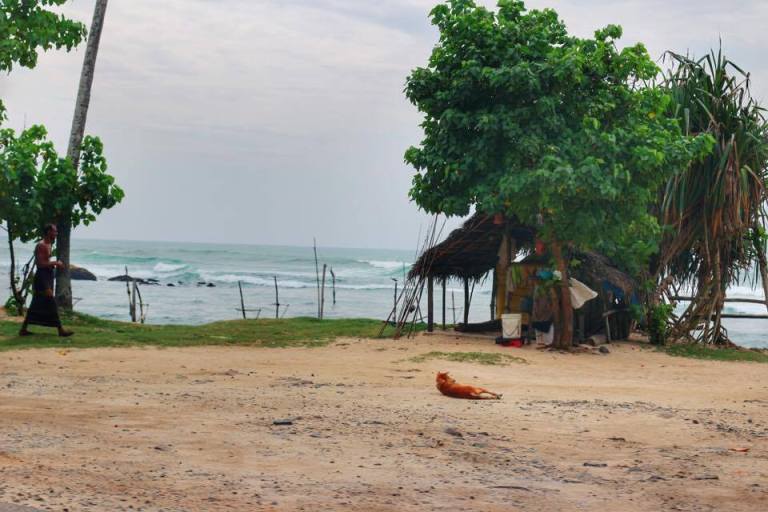RO: Gigelul de ieri, cu tuk tuk-ul din Galle, ne asteapta deja in fata casei, cu alti trei amigos gata sa ne plimbe toata ziua. “Your tuk-tuk t’day, ma friend, your tuk tuk”. Bun, pai daca asa ne-a fost vorba ieri, in fata fortului din Galle, asa facem! 3000 de rupii de tuk-tuk pentru vazut plaja de la Mirissa, cateva opriri pe drum si inapoi la vila in Unawatuna. Batem palma si pornim la drum cu alaiul de tuk tuk-uri. Ne porneste Gigel radioul si din boxa din spatele nostru duduie cand un pic de muzica traditionala baila, cand un pic de Alexandra Stan. Macar asa sa ne luam gandul de la depasirile demente care se intampla in jurul nostru. Pana la urma, pare ca asta ar fi cauza traficului absolut infernal din Sri Lanka, nu neaparat drumurile proaste. Daca stai sa te gandesti, de cand s-a incheiat razboiul civil dintre singalezi si tamili, infrastructura Sri Lankai s-a dezvoltat destul de mult. Si asta intr-un timp scurt (aviz amatorilor conationali :D). Insa modul isteric de a conduce, obiceiul complet irational de a depasi cand ti-e lumea mai draga, eventual in curba, pe linie continua si taman cand vine din fata ditamai autobuzul, asta face ca orice drum, oricat de scurt, sa fie o aventura care pare ca nu se mai termina. Asa ca ce sa ne mai mire ca orasul Matara ne-a terminat psihic. Atata nebunie si isterie, atatea masini, scutere si poluare, atatia oameni plonjand sa traverseze strada, atatea cladiri, autobuze, haos! O dementa de oras in care sincer, n-ai ce cauta. Dar daca vrei putin din atmosfera si nebunia de pe strazile indiene, e un loc bun de “training”.
EN: Yesterday’s driver, the one with the tuk tuk in Galle, is already waiting for us in front of the house, along other three amigos ready to show us around all day long. “Your tuk-tuk t’day, ma friend, your tuk tuk”. Ok, if that’s what we decided yesterday, in front of Galle Fort, so be it! 3000 rupees per tuk tuk to see Mirissa Beach, a couple of stopovers on the way and then back to Unawatuna. It’s a deal and we’re starting our trip with the tuk tuk suite. The driver starts the radio and we can hear in the back sound speaker either a bit of traditional baila music, either some songs from Alexandra Stan. At least we manage to forget about the insane over takings that happen around us. In the end, this seems to be the cause of the infernal traffic in Sri Lanka, not necessary the bad roads. If you think about it, since the civil war between the Sinhalese and the Tamils has ended, the infrastructure in Sri Lanka has developed a lot. And that happened in quite a short period of time (for all concerned :D). But the hysterical way of driving, the completely irrational habit of over taking when you least expect, even on a curve, on continuous road line when a huge bus is coming from the other side of the road, all these make every trip, no matter how short, to be a never ending adventure. So there’s no wonder that Matara city psychologically killed us. So much madness and hysteria, so many cars, scooters and pollution, so many people plunging to cross the street, so many buildings, buses, chaos! A mad city where honestly, there’s nothing to do. But if you want a bit of Indian hustle and bustle, this is a good place to start the “training”.









RO: Bun, ajungem la primul obiectiv de pe lista, intregi si fara niciun accident la activ. Gigel inca se mai amuza de grimasele noastre terifiate si printre reprizele de ras ne face semn sa ne descaltam. “Shoes off, Buddha no shoes”. Bine, ne conformam, nu putem fi pretiosi in casa lui Buddha cel inalt de 39 de metri. Lasam incaltarile in tarana si pornim desculti spre templul Weherahena, primul templu budist subteran pe care il vedem. O galerie uriasa in tunel, plina de pasaje cu picturi colorate, care prezinta viata lui Buddha prin povesti Jataka. Ce-i drept, templul nu are o istorie fabuloasa si abia ce-a fost terminat prin anii ’70, insa tunelul este chiar impresionant, iar statuia lui Buddha e uriasa. Apropo, pozatul cu spatele la Buddha este interzis complet si considerat total lipsit de respect.
EN: Ok, we get to our first point on the list, safe and with no serious accident on record. The driver is still making fun of our terrified grimaces and between all the laughing makes us a sign to take our shoes off. “Shoes off, Buddha no shoes”. Ok. we’ll comply with the rules, we can’t be precious in Buddha’s house. We leave our shoes in dirt and we’re heading barefoot to Weherahena Temple, the first underground Buddhist temple we’ve ever seen. A huge gallery in the tunnel, full of colorful paintings that represent Buddha’s life through Jataka stories. Honestly, the temple doesn’t have a fabulous history and it has just been finished in the ’70s, but the tunnel is really impressive and Buddha’s statue is huge. By the way, taking pictures turning your back on Buddha is completely prohibited and considered completely disrespectful.

















RO: Terminam turul in tunel, urcam sus pe Buddha si-apoi o luam din loc spre asa zisul “elephant ride” pe care-l tot ridica in slavi Gigel. Dupa experientele din Bali si Malaezia la diverse orfelinate de elefanti, ni s-a cam luat de orice inseamna tur turistic cu bietele animale, ba si mai mult de plimbarile pe spinarea elefantilor. Si intre noi fie vorba, nu stiam sa existe vreun loc de vazut elefanti in zona, cel mai aproape poate sa fie Parcul National Yala. Dar pana la Yala mai mancam vreo trei portii de orez si curry, deci sigur nu mergem acolo. Dar hai sa fim spontani si sa mergem pe mana localnicului. Hai sa lasam OCD-ul deoparte macar pentru o singura data in plecari si sa nu mai avem totul pregatit cap-coada. Asa ca da, Gigel, ne esti simpatic si mergem si la “elephant ride”. Buuuun, inca o lectie invatata in Sri Lanka: niciodata nu renunta la temele bine facute de acasa in favoarea unei pareri primite de la un tuk-tuk-gist. Elephant Ride-ul vietii este de fapt o curte a unui templu in care alti Gigei, prieteni cu Gigelul nostru, au doua animale amarate, tinute in lanturi si scoase la distrat turistii. Pentru o suma “modica” ai deosebita onoare de a te sui pe elefanti si de a-ti face selfiul bun de pus pe Facebook. Toata floarea ca vestita a Gigeilor ne inconjoara si ne fac oferte care mai de care mai “tentante”. Refuzam ditractia si cerem sa pornim mai departe.
EN: We finish the tour in the tunnel, we go up on Buddha’s statue and then we’re heading to the so called “elephant ride” that our driver keeps praising to the skies. After our experiences in Bali and Malaysia at various elephant orphanages, we are quite fed up with any touristic tour that involves the poor animals or the elephant rides. And between you and me, we didn’t know about any place to see elephants nearby, except the Yala National Park. But until we get to Yala there’s plenty of time to have three portions of rice and curry, so for sure we’re not going there. But let’s be spontaneous and trust the local. Let’s leave the OCD behind and for one time only not have everything prepared in our trips. So yup, tuk tuk driver, you’re quite nice and we’ll go to the “elephant ride”. Oooook, another lesson learnt in Sri Lanka: do not ever give up to your plans in favor of a tuk tuk driver opinion. The so called elephant ride is actually a courtyard of a temple where other people, friends of our driver, have two poor animals, kept in chains and used for entertaining the tourists. For a “moderate” amount of money you have the special honor to jump on the elephant’s back and take the perfect selfie for your Facebook. All those persons surround us and try to make us different tempting offers. We refuse the amusement and we ask to go further.







RO: La farul de la Dondra, cel alb imaculat de il vedem in poze. Dar e inchis si nu se poate vizita. Ei, n-o fi ea cea mai buna zi de “turism” pentru noi, dar pentru prima oara in trei zile avem un pic de soare. Iar plaja mica si intregul golf, cu barcile de pescari si copilasii de localnici alergand dintr-o parte in alta, pare sa fie scoasa fix dintr-o carte postala. Si uite asa ne dam seama ca suntem toti meteo-sensibili si ca nu putem sa apreciem o plaja sri lankeza la adevarata ei valoare daca nu avem soare si vreme buna 😀 Asa s-o explica poate si parerea nu tocmai grozava despre Unawatuna. Parca ne tenteaza sa ramanem cateva minute la plaja aici, dar pomul laudat de la Mirissa castiga dezbaterea.
EN: To Dondra Lighthouse, the immaculately white one that we see in the pictures. But it is closed and we cannot visit it. Well, this is definitely not our best day for “tourism”, but for the first time in three days we have a bit of sunlight. And the small beach and the entire bay, with the fishermen boats and all the children locals running from one side to the other, looks like a real postcard. And that’s how we realize that we are all sensitive to weather and that we cannot appreciate a Sri Lankan beach to its real value if we do not have sun and good weather 😀 Maybe that explains our not so great opinion about Unawatuna. We’re tempted to stay some more minutes here, but Mirissa wins the debate.








RO: Urcam in tuk tuk-uri si-n doi timpi si trei miscari ajungem la Mirissa. Si adevarul e ca dupa dezamagirea din Unawatuna, nicio descriere din ghidurile turistice de genul “cea mai cea plaja din Sri Lanka” nu a reusit sa ne seteze niste asteptari mai de Doamne-ajuta. Asa ca in mod surprinzator, Mirissa chiar ne place! O plaja ingusta dar foarte hipstereasca, cu terase putine si deloc invazive ca cele din Unawatuna, oameni relaxati, mai multi turisti si un peisaj frumos. Hoteluri sunt putine, mai multe niste case de oaspeti rustice si modeste, restaurantele sunt niste barace de lemn simple si relaxate, si per total chiar zici ca nu esti in sudul ultra-comercial si turistic al Sri Lankai. Are un pic de vibe estic, mai putin explorat 🙂 Atata doar ca am ajuns fix in mijlocul zilei (din nou!) si fasia de plaja care intra in ocean, de o vazusem in pozele de pe internet, este cum altfel, daca nu inundata.
EN: We’re getting into our tuk tuks and in a brace of shakes we get to Mirissa. The truth is that after the disappointment from Unawatuna, no description like “the most beautiful beach in Sri Lanka” has succeeded to set some normal expectations for us. So surprisingly, we really like Mirissa! A narrow beach, but quite hipsterish, with few terraces that are not invasive at all (unlike the ones from Unawatuna), relaxed people, more tourists and a beautiful scenery. Fewer hotels, more modest guesthouses, the restaurants are some simple wooden shacks, and all in all, it seems like we’re not in the ultra-commercial southern part of Sri Lanka. It has an eastern vibe, less explored 🙂 Just that we got here in the middle of the day (again!) and the strip of sand that goes into the ocean is of course, flooded by the high tide.












RO: Si numai bine se intuneca cerul din nou, ca doar cat soare sa avem intr-o singura zi 🙂 Dar nu e bai, pentru ca mai avem de vazut si pescarii, pana nu e prea tarziu. Cum ce pescari, pescarii pe picioroange, imaginea emblematica a Sri Lankai, devenita faimoasa de cand cu pozele talentatului Steve McCurry. Acum s-o zicem pe aia dreapta, pe care nici noi n-am vrut sa o auzim 🙂 Pescarii cei originali, cu adevarat pescari traditionali, vin dimineata la prima ora. Adica pe la un onorabil 5 dimineata. Tot ce este vazut dupa aceasta ora si mai ales cei de la apus, de ii vedem in pozele acelea perfecte de pe cartile postale, sunt pescarii-fake, actori care cer bani pentru a fi pozati de turisti. In fine, stim toate acestea deja, dar tot vrem sa-i vedem. Ce e insa enervant si deranjant si complet nedrept fata de “masinariile albe de facut bani” (aka turistii) este faptul ca totul a devenit atat de comercial si turistic, ca multi dintre noi nu mai au nici bunul simt de a-si juca rolul intr-un mod cat mai autentic. Si-n plus fata de asta, preturile cerute sunt de-a dreptul exagerate. Auzi tu 4000 de rupii de aparat foto! Cum sa nu ti se urce sangele in cap?! Dar cand vin autocarele de turisti dispusi sa plateasca oricat pentru EXPERIENTA, nu-l poti blama pe cel care cere, ci pe cel care e dispus sa ofere. Gigel observa nemultumirea noastra si aranjeaza planetele sa ne duca la “cei mai adevarati si autentici” pescari. “Good price, ma friend, only 1500 rupees. All.”. Bun, 1500 de rupii si avem toti zece permisiune sa facem poze cu pescarii. Asa mai vii de-acasa.
EN: And once again the sky is getting darker, as it was too much sun for only one day 🙂 But that’s not an issue, as we also have to see the fishermen until it’s not getting too late. What fishermen? Well the stilt fishermen, the iconic image of Sri Lanka, which became famous through talented Steve McCurry’s photographs. And now let’s say the true part of the story, the one that we didn’t want to hear either 🙂 The original fishermen, the truly traditional ones, are coming here at first hour in the morning. Meaning at an honorable 5 AM. Everything that is seen after this hour and at sunset, people that we see in those picture perfect postcards, are all fake-fishermen, actors that ask for money to be photographed by tourists. Anyway, we already know all these, but we still want to see them. What is though annoying and disturbing and completely unfair towards the “white money making machines” (aka tourists) is the fact that everything has turned into something so commercial and touristic, that many of them do not even play their part in an authentic way. And beside this, the prices they ask are completely outrageous. 4000 rupees per photo camera! How can this not get on our nerves? But when tourist buses come here with tourists willing to pay no matter how much for the EXPERIENCE, you cannot blame the one who asks for the money, but the one who offers. Our driver notices our discontent and arranges the planet to take us the most “real and authentic” fishermen. “Good price, ma friend, only 1500 rupees. All.” Ok, 1500 rupees and we are all getting permission to photograph the fishermen. That’s more like it. 



RO: Din pacate pescuitul pe picioroange, oricat de traditional si tipic Sri Lankai ar fi, incepe sa nu mai fie atat de popular. Nici nu e de mirare, daca stai sa te gandesti cat e de complicat sa iti mentii echilibrul ore in sir pe un stalp de lemn si o bara perpendiculara pe care stai asezat. Si poate ca pare primitiv si preistoric modul acesta de a pescui, insa surpriza, se pare ca a aparut in vremuri recente, mai exact candva in timpul celui de-al doilea razboi mondial. Si multa vreme a fost preferat plaselor moderne, ca sa nu sperie pestii din zona coastei. In felul acesta se asigurau oamenii ca au intotdeauna pesti in apa si ca ii pot pescui, oricand, oricum, fara sa foloseasca nici macar momeala.
EN: Unfortunately, fishing on stilts, no matter how traditional to Sri Lanka would be, is starting to be less popular. No wonder if you think about how complicated it is to keep your balance for hours on a wooden stilt and a perpendicular crossbar that you sit on. And maybe this looks primitive and prehistoric, but surprisingly, this method of fishing only appeared in recent times, more precisely somewhere during the second world war. And long time it was preferred to the modern nets, because these were scaring the fish. In this way people were sure that there were always fish in their waters and that they can catch them anytime, anyhow, without using any bait.

RO: Am vazut si Mirissa, am pozat si pescarii, we call it a day. Nu si Gigel, care ne opreste si la crescatoria de broaste testoase de apa. De fapt si de drept este un fel de orfelinat unde oamenii aduna broastele testoase ranite sau ouale abandonate pe plaja. Pentru ca da, desi este complet ilegal in Sri Lanka sa culegi ouale depuse de testoase, mai nimeni nu respecta legea. Asa ca oamenii de la orfelinat culeg ouale aflate in pericol iar cand broastele ajung la cateva zile de maturitate le elibereaza. La fel si cu cele ranite, le trimit inapoi in apa imediat ce pot supravietui fara ajutor.
EN: We’ve seen Mirissa, we photographed the fishermen, we call it a day. But the driver doesn’t, as he stops us at the turtles nursery. In fact, this is a kind of orphanage where people bring the injured turtles or the abandoned eggs on the beach. Because yes, even though it is completely illegal to pick up the eggs laid by the turtles, almost no one respects the law. So the people from the orphanage pick the endangered ones and when the turtles get to a couple of days of maturity they set them free. The same thing happens with the mature ones, they send them back to the water once they can survive with no help.

RO: Si-acum deliciul zilei. Plata tuk uk-urilor. 3000 de rupii, dupa cum am vorbi de dimineata. De unde! Gigeii se razgandesc si realizeaza subit ca intelegerea era pentru un singur drum, nu si pentru intors. Asa ca au nevoie de 6000 de rupii de tuk tuk. Incepe o negociere agresiva din care n-avem cum sa iesim castigatori. Oprim circul la 4000 de rupii si ne intoarcem in Unawatuna, sa ne inecam amarul intr-o bere Lion si o portie de curry picant. Iar la final de zi, in ciuda tuturor picanteriilor, ramanem cu un gust usor amar. Am incercat sa avem o experienta autentica, cu oameni de-ai locului care sa ne arate tara lor. Am vut incredere in oamenii despre care am citit ca sunt primitori, amabili, buni si cinstiti. N-am vrea sa generalizam si stim ca nu tuk tuk-gistii fac o tara ca Sri Lanka, insa am primit in schimb turism de masa, locuri comerciale si oameni pusi pe pacalit turisti. Dar era de asteptat sa se intample asta in sud, cel mai comercial si turistic loc din Sri Lanka. Avem sa vedem insa ca lucrurile vor sta complet diferit in centrul tarii, acolo unde Sri Lanka este intr-adevar cea prezentata in toate ghidurile si povestile calatorilor.
EN: And now the highlight of the day: Paying the tuk tuks. 3000 rupees, as agreed in the morning. Ya right! The drivers change their mind and suddenly realize that the agreement was for only one way, not for return. So they ask 6000 rupees per tuk tuk. We start an aggressive negotiation where we cannot end up as winners. We stop all this masquerade at 4000 rupees and we’re back to Unawatuna, to drown our worries into a Lion beer and a spicy curry. And at the end of the day, against all the spiciness, we’re left with a bitter taste in our mouth. We wanted an authentic experience, with locals that show us their country. We trusted the people that we were told to be welcoming, kind and honest. We don’t want to make it a general rule and we know that tuk tuk drivers can’t make a country like Sri Lanka, but we got in return mass tourism, commercial places and people trying to fool the tourists. But this was expected in the south, the most commercial and touristy place in Sri Lanka. We will see that things will be completely different in the center of the country, where Sri Lanka is indeed the one presented in all the guides and all traveler’s stories.

